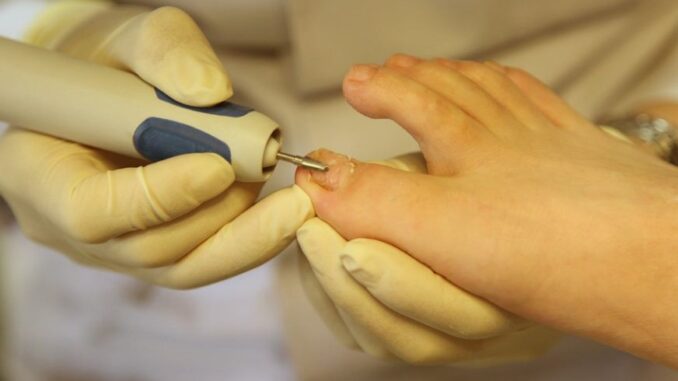
Ingrown toenail fungus is also known as onychomycosis, a combination of dermatophytes, saprophytic mold, and yeast infections. It is a common infection and people increasingly seek Houston Fungus Toenails Treatment. The T.Rubrum organism has become dominant in the united states. Half of the abnormal toenails are mycotic. Studies have shown some risk factors are tinea pedis, aging, diabetes, living with people affected with toenail fungus, immunodeficiency, and psoriasis. The fungus can be found in hotel carpets, pool decks, and public showers. After coming to contact with the fungus you might proceed to wear shoes. The shoes provide a good environment for the fungus to thrive because they are dark, moist, and warm. As the fungus thrives it pressurizes the nail to break the hyponychial seal allowing the fungus to penetrate the nail bed. If there is continued exposure to a wet environment the fungus continues to thrive. In the foot, the dermatophytes or fungus produce keratinases that start infecting the lesser toes and spread gradually extending to other nail units. Once the nail is breached the fungus infects the nail bed if not stopped in time.
The ingrown toenail fungus begins in the nail bed with acute infection because of its low-grade response to infections. This causes it to progress to a chronic phase infected the whole nail bed. As the fungal infection continues to affect the rest of the toenail the nail bed tries to thicken the nail to get rid of the fungal infection. The fungus continues attacking the nail plate, detaching and distorting the toenail with time. At this point, the podiatrist might recommend Laser Treatment for Toenail Fungus – Houston before the infection becomes worse. When the nail plate becomes misaligned and the infection enters a chronic stage meaning the infection can be even in the bloodstream.
History
The evaluation of the patient is done to evaluate the nail disease in terms of duration, progress, and success of previously tried treatments. Other important information your podiatrist needs includes the presence of hepatitis or travel to areas where hepatitis is found, alcohol usage, and recreational activities that will expose you to reinfection of the toenail fungal infection. When the toenails are thickened and discolored it is mistaken for another disease but it might be a fungal infection. The toenail is estimated to grow at one millimeter a month so the podiatrist measures the affected toenail to determine the duration of treatment to ensure the infected toenail grows out. However, it is good to consider other factors such as aging and peripheral vascular insufficiency leading to a slow toenail growth rate.
Management / Treatment
The most effective has been the use of systematic antifungals and Houston Laser Fungal Nail Treatment. In moderate to severe toenail fungus infection oral antifungal therapy is considered. Diabetic patients too might get to use the oral antifungal treatment. Combination therapy of periodic debridement, and topical agents might produce better results other than the systematic treatment alone. For mild to moderate toenail fungal infections, the podiatrist might avoid systematic antifungals and opt for topical fungal therapies that have proved to cure. A complete cure is only assumed when there is a completely clear nail and a negative mycology test. However, for severe infections, the nail might not completely clear because a post-treatment fungal culture may be detected.
Oral therapy is the most effective but those who prefer not to do it can have topical therapy or laser toenail fungus removal Houston. However, there is no clear effective topical choice that can be recommended.
The management of toenail fungus spread lies on each one of us to educate each other on shared spaces and items. The public needs to know the appropriate footwear in shared spaces such as health clubs, saunas, and swimming pools. If the work environment seems to encourage fungal infections such as washing dishes they should be encouraged to always have protective gear such as gloves. As much as a patient would like to treat toenail fungus with over-the-counter products it is better to visit a foot doctor for screening, follow-up, and documentation of progress and compliance with the tried therapies. It will be easier to determine when therapy change is needed and nail complete or partial removal is needed. If you delay in seeking care the toenail might become completely disfigured and painful.
